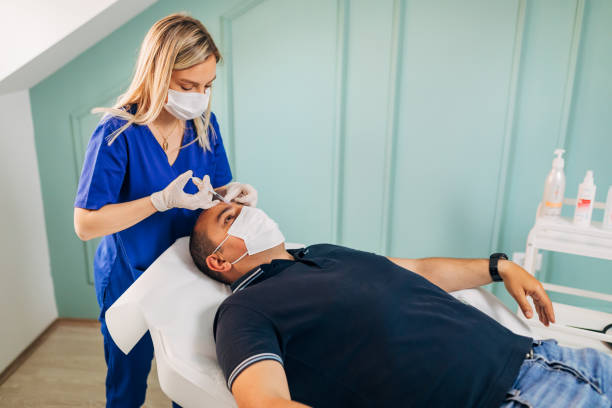Hair loss affects people of all ages and genders, but there are treatments available. Hair transplant is a permanent and effective solution, but there are other options to consider. In this article, we’ll compare different hair loss treatments to help you choose the best one for your needs. Hair loss can be a challenging experience, and while some embrace it, others seek treatment to restore their hair.
Understanding Hair Loss
Before we dive into the different hair loss treatments, it’s important to understand why hair loss occurs. Hair loss can be caused by a variety of factors such as genetics, hormonal changes, and medical conditions. In some cases, hair loss may be temporary and will resolve on its own, while in other cases, it may be permanent.
Hair transplant surgery in Sydney is commonly used to treat male pattern baldness, the most common form of hair loss that affects approximately 50% of men by the age of 50. Female pattern baldness can also occur, but is less common. Other forms of hair loss, such as
alopecia areata, telogen effluvium, and scarring alopecia, may also be treated with hair transplant surgery in Sydney.
What is Hair Transplant and How Does it Work?
A hair transplant is a surgery that moves hair follicles from one part of the scalp to balding areas, resulting in a fuller head of hair. There are two types of procedures: follicular unit transplantation (FUT) and follicular unit extraction (FUE). FUT involves removing a strip of skin from the scalp and dissecting it into individual hair follicles, while FUE involves removing individual hair follicles directly from the scalp. Although a hair transplant is a permanent solution, it is an expensive and invasive procedure that may not be suitable for everyone.
Other Hair Loss Treatments
Other hair loss treatments are available which are less invasive and less expensive than hair transplant, making them suitable for those who are not good candidates for surgery or cannot afford it.
Medications
Minoxidil and finasteride are medications used to treat hair loss. Minoxidil is applied topically to the scalp, while finasteride is taken orally. Both medications are FDA-approved and have been proven to be effective in clinical trials.
Hairpieces
Hairpieces, or wigs, are a non-surgical option for hair loss. They come in various styles and can be made from synthetic or human hair. They can be attached to the scalp with clips, tape, or adhesive, and can be easily removed.
Laser Therapy
Low-level laser therapy (LLLT) is a non-invasive treatment that uses light to stimulate hair growth. LLLT devices emit low-level laser light that is absorbed by the hair follicles, which can help promote hair growth. LLLT has been shown to be effective in clinical studies and is an FDA-approved treatment for hair loss.
Platelet-Rich Plasma Therapy
Platelet-rich plasma (PRP) therapy is a non-surgical treatment that involves injecting a concentrated solution of the patient’s own blood platelets into the scalp. The platelets contain growth factors that can stimulate hair growth and improve hair density. PRP therapy has been shown to be effective in clinical studies, but more research is needed to fully understand its effectiveness.
Scalp Micropigmentation
Scalp micropigmentation (SMP) is a non-surgical cosmetic procedure that tattoos tiny dots on the scalp to resemble hair follicles. It can create the illusion of a fuller head of hair or camouflage scars from surgery. SMP is a good alternative for those who can’t undergo surgery or prefer a less invasive solution.
Comparison of Hair Transplant vs. Other Treatments
Consider these factors when comparing hair transplant to other hair loss treatments:
Effectiveness
Although hair transplant is the most effective and permanent solution for hair loss, other treatments like medications, laser therapy, and PRP therapy are also effective in promoting hair growth and reducing hair loss.
Safety
Hair transplant is a surgery that has risks such as bleeding, infection, and scarring. Non-surgical treatments like medications, laser therapy, and PRP therapy are generally safe, but may have minor side effects such as itching, redness, or irritation.
Cost
Hair transplant is costly and may cost thousands of dollars, while non-surgical treatments such as medications, laser therapy, and PRP therapy are generally cheaper, but may require ongoing treatment to maintain results.
Choosing the Best Option for You
When choosing a hair loss treatment, it’s important to consider your individual needs and preferences. If you want a permanent solution to hair loss and are willing to undergo surgery, hair transplant may be the best option for you. If you prefer a non-surgical solution or cannot afford surgery, other treatments such as medications, laser therapy, or PRP therapy may be a better fit.
Final Thoughts
Hair loss can be a distressing experience for many people, but fortunately, there are several treatment options available to restore hair growth. While hair transplant is considered the most effective and permanent solution, other treatments such as medications, hairpieces, laser therapy, platelet-rich plasma therapy, and scalp micropigmentation can also help reduce hair loss. When deciding which option is best for you, it’s important to consider factors such as effectiveness, safety, and cost. Consulting with a dermatologist or hair restoration specialist can also provide valuable guidance in determining the best course of action for your individual needs. Ultimately, the most suitable hair loss treatment will depend on your specific circumstances and personal preferences.

